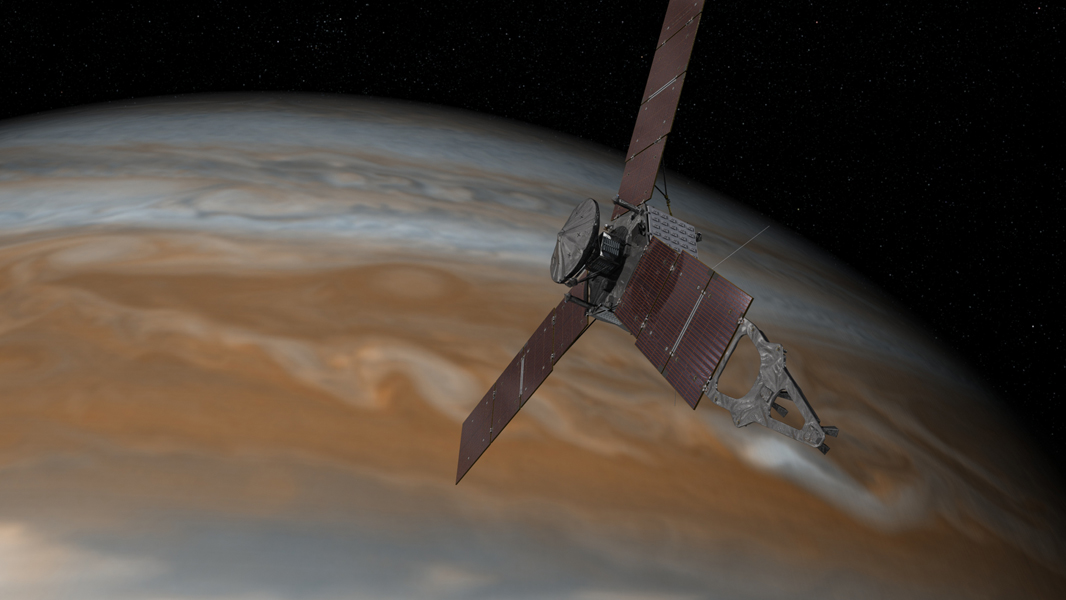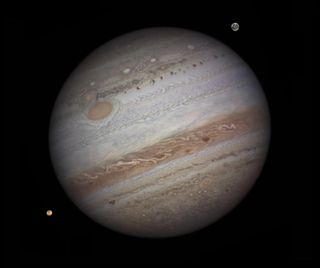
As the New Horizons probe leaves diminutive Pluto in its rearview mirror, another NASA spacecraft is closing on the solar system's biggest planet.
NASA's Juno probe is now less than one year away from its rendezvous with Jupiter. Juno, which launched in August 2011, is scheduled to slip into orbit around the gas giant on July 4, 2016.
The solar-powered Juno will study Jupiter's interior by precisely mapping the huge planet's gravitational and magnetic fields. The spacecraft's observations should reveal key insights about Jupiter's structure — including whether or not the planet has a solid core — and its formation and evolutionary history, mission team members have said. [Animated Look at Juno's Jupiter Mission ]
Juno will also capture the first up-close images of Jupiter's polar regions.
"We're already more than 90 percent of the way to Jupiter, in terms of total distance traveled," Juno principal investigator Scott Bolton, of the Southwest Research Institute in San Antonio, said in a statement. "With a year to go, we're looking carefully at our plans to make sure we're ready to make the most of our time once we arrive."
That careful look has resulted in some changes. The original plan called for Juno to circle Jupiter once every 11 days, and to complete a total of 30 orbits over the course of a 15-month prime mission. But mission officials have now decided on a 14-day orbit and 32 total Jupiter laps over the course of 20 months. (Juno will arrive at this orbit by performing a slightly shorter orbital-insertion engine burn than previously planned.)
"The revised cadence will allow Juno to build maps of the planet's magnetic and gravity fields in a way that will provide a global look at the planet earlier in the mission than the original plan," NASA officials wrote in the same statement.
Get the Space.com Newsletter
Breaking space news, the latest updates on rocket launches, skywatching events and more!
Juno's orbit will be highly elliptical, at times bringing the probe to within just a few thousand miles of the planet's cloud tops. The 14-day version should give the mission team more time to react to any surprises that might pop up in between such close approaches, NASA officials added.

"We have models that tell us what to expect, but the fact is that Juno is going to be immersed in a strong and variable magnetic field and hazardous radiation, and it will get closer to the planet than any previous orbiting spacecraft," Bolton said. "Juno's experience could be different than what our models predict — that's part of what makes space exploration so exciting."
Juno is the second mission selected under NASA's medium-class New Frontiers program. The first New Frontiers effort was the $723 million New Horizons mission, which launched in January 2006 and on Tuesday (July 14) performed history's first flyby of Pluto and its moons.
Follow Mike Wall on Twitter @michaeldwall and Google+. Follow us @Spacedotcom, Facebook or Google+. Originally published on Space.com.
Join our Space Forums to keep talking space on the latest missions, night sky and more! And if you have a news tip, correction or comment, let us know at: community@space.com.

Michael Wall is a Senior Space Writer with Space.com and joined the team in 2010. He primarily covers exoplanets, spaceflight and military space, but has been known to dabble in the space art beat. His book about the search for alien life, "Out There," was published on Nov. 13, 2018. Before becoming a science writer, Michael worked as a herpetologist and wildlife biologist. He has a Ph.D. in evolutionary biology from the University of Sydney, Australia, a bachelor's degree from the University of Arizona, and a graduate certificate in science writing from the University of California, Santa Cruz. To find out what his latest project is, you can follow Michael on Twitter.
Most Popular

